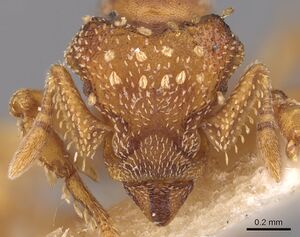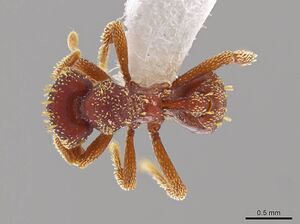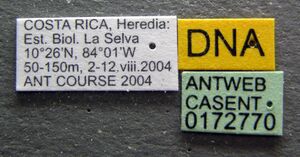Eurhopalothrix gravis
| Eurhopalothrix gravis | |
|---|---|

| |
| Scientific classification | |
| Kingdom: | Animalia |
| Phylum: | Arthropoda |
| Class: | Insecta |
| Order: | Hymenoptera |
| Family: | Formicidae |
| Subfamily: | Myrmicinae |
| Tribe: | Attini |
| Genus: | Eurhopalothrix |
| Species: | E. gravis |
| Binomial name | |
| Eurhopalothrix gravis (Mann, 1922) | |
Longino (2013): This species occurs in mature to second growth wet forest habitats. It is a lowland species, occurring from sea level to 1100 m in Central America. Many specimens are from Berlese and Winkler samples of sifted litter and rotten wood from the forest floor, but unlike many other species, specimens have also been found by direct search, usually isolated workers under loose bark of rotten wood. An alate queen was collected in a flight intercept trap in Belize, 19–28 August 2007 (P. W. Kovarik). Where it has been collected it is typically low density, occurring in less than 1% of Winkler samples, but one exception was a site at 1100 m elevation on the Barva Transect in Costa Rica, where it occurred in 8% of samples.
Identification
| Table 1 (Chaul, 2022). Morphological character comparison between E. gravis, E. reichenspergeri and E. xibalba. | |||
|---|---|---|---|
| Characters | E. gravis | E. reichenspergeri | E. xibalba |
| Labral lobes | Short | Long | Long |
| Head—inclination of posterolateral margin of vertex (Fig.1, A–C) | Inclination different from xibalba and reichenspergeri | Inclination similar to xibalba | Inclination similar to reichenspergeri |
| Standing setae | Thin | Thick | Thick |
| Number of setae on promesonotum | 6 | 8 | 6 |
| Number of setae on A4 | 8 | 12 | 10 |
| Mesosoma dorsal profile | With a slight break between promesonotum and propodeum | Continuous between promesonotum and propodeum | Similar to reichenspergeri |
| Propodeal lamella | As long as its basal width | Longer than its basal width | Similar to gravis |
| Ground pilosity | Densely distributed | Sparsely distributed | As dense as in gravis, but hairs are thicker |
| Punctation on pleura | Shallow | Deeper than in gravis | Deeper than in both |
| Overall body size | HW 0.83–0.94, HL 0.75–0.83 | HW 0.78–0.88, HL 0.76–0.82 | HW 0.57–0.66, HL 0.56–0.64 |
 Figure 1. Comparison of head in full-face view (A–C) and dorsal view of the body (D–F) of workers of Eurhopalothrix species. A and D, E. gravis (CASENT0107554, images by April Nobile); B and E, E. reichenspergeri (B is UFV-LABECOL-000725 and E is UFV-LABECOL-010765); C and F, E. xibalba, (INB0003665110, images by Brendon Boudinot). Scale bars from A to C are 0.2 mm and from D to F 0.5 mm. Specimen in B has one missing seta (left side of face, in the middle row), a common condition found in most dry specimens. Posterior vertexal corners are indicated by white arrow heads and anterior vertexal corners by black ones (size of the margin between them and their angles varying). Specialized setae are circled in white, specimen in D has one additional unpaired setae, circled in red, not observed in any other specimen studied (see comments under E. reichenspergeri redescription). (Chaul, 2022, Fig. 1)
Figure 1. Comparison of head in full-face view (A–C) and dorsal view of the body (D–F) of workers of Eurhopalothrix species. A and D, E. gravis (CASENT0107554, images by April Nobile); B and E, E. reichenspergeri (B is UFV-LABECOL-000725 and E is UFV-LABECOL-010765); C and F, E. xibalba, (INB0003665110, images by Brendon Boudinot). Scale bars from A to C are 0.2 mm and from D to F 0.5 mm. Specimen in B has one missing seta (left side of face, in the middle row), a common condition found in most dry specimens. Posterior vertexal corners are indicated by white arrow heads and anterior vertexal corners by black ones (size of the margin between them and their angles varying). Specialized setae are circled in white, specimen in D has one additional unpaired setae, circled in red, not observed in any other specimen studied (see comments under E. reichenspergeri redescription). (Chaul, 2022, Fig. 1)
Keys including this Species
Distribution
Southern Mexico to Costa Rica; Brazil (Santa Catarina)?
Latitudinal Distribution Pattern
Latitudinal Range: 17.2° to -23.251°.
| North Temperate |
North Subtropical |
Tropical | South Subtropical |
South Temperate |
- Source: AntMaps
Distribution based on Regional Taxon Lists
Neotropical Region: Belize, Colombia, Costa Rica, Dominica, Guatemala, Honduras (type locality), Lesser Antilles, Mexico, Nicaragua, Puerto Rico, Venezuela.
Distribution based on AntMaps
Distribution based on AntWeb specimens
Check data from AntWeb
Countries Occupied
| Number of countries occupied by this species based on AntWiki Regional Taxon Lists. In general, fewer countries occupied indicates a narrower range, while more countries indicates a more widespread species. |

|
Estimated Abundance
| Relative abundance based on number of AntMaps records per species (this species within the purple bar). Fewer records (to the left) indicates a less abundant/encountered species while more records (to the right) indicates more abundant/encountered species. |

|
Biology
|
Castes
Worker
Images from AntWeb
   
| |
| Syntype of Eurhopalothrix gravis. Worker. Specimen code casent0900928. Photographer Will Ericson, uploaded by California Academy of Sciences. | Owned by NHMUK, London, UK. |
   
| |
| Worker. Specimen code inb0003212671. Photographer Brendon Boudinot, uploaded by University of Utah. | |
Queen
Images from AntWeb
   
| |
| Queen (alate/dealate). Specimen code casent0172770. Photographer April Nobile, uploaded by California Academy of Sciences. | Owned by CAS, San Francisco, CA, USA. |
   
| |
| Queen (alate/dealate). Specimen code inbiocri001237722. Photographer Brendon Boudinot, uploaded by University of Utah. | Owned by INBio. |
Nomenclature
The following information is derived from Barry Bolton's Online Catalogue of the Ants of the World.
- gravis. Rhopalothrix (Rhopalothrix) gravis Mann, 1922: 40, fig. 19 (w.q.m.) HONDURAS. Wheeler, G.C. & Wheeler, J. 1955a: 117 (l.). Combination in Eurhopalothrix: Brown & Kempf, 1960: 211. Senior synonym of reichenspergeri: Brown & Kempf, 1960: 211.
Unless otherwise noted the text for the remainder of this section is reported from the publication that includes the original description.
Description
Worker
Longino (2013) - HW 0.83–0.94, HL 0.75–0.83, SL 0.47–0.54, SLL 0.05–0.07, CI 110–115, SLI 10–14 (n=7). Labrum anterolateral gibbosities of basal portion developed as sharply right-angled, ventrally-directed teeth, apical portion short, flexed dorsally, distinctly bilobed, anterior lobes well separated; apex of each lobe with a fringe of very short translucent setae and 2 longer pointed translucent setae; mandible triangular, dorsal surface convex, minutely punctulate, dull, rounding into ventral surface; interior surface concave, smooth and shining; masticatory margin with two tooth rows, an outer row of 10 flattened, acute teeth, second and third tooth from base larger than other teeth; an inner row of 3 long needle-shaped teeth, behind outer teeth 3–6 and projecting beyond them, nearly 2x length of flanking outer teeth; scape with moderately developed basal lobe; scrobe deep, sharply delimited dorsally and ventrally, abutting deep antennal socket; surface of scrobe weakly foveolate anteriorly, smooth and shiny posteriorly; eye with about 5 ommatidia across greatest diameter; clypeus approximately planar, shallowly roughened, dull; juncture of clypeus and frons impressed; sides of head above eyes strongly angulate; surface of face uniformly convex, shallowly rugulose, anterior frons with moderately developed longitudinal medial carina; occipital carina indistinct; undersurface of head uniformly rugulose; postgenal suture a well-developed longitudinal trough.
Promesonotal profile evenly convex, posterior margin a short step dropping to sloping, flat dorsal face of propodeum; metanotal groove not impressed; dorsal and posterior faces of propodeum distinct, meeting at obtuse angle, dorsal face shorter than posterior face; propodeal spine laminar, translucent, triangular, acute, ventral margin curving into narrow infradental lamella that extends down posterior face to propodeal lobe; propodeal spiracle distinct, directed posteriorly; dorsal promesonotum rugulose; anterior pronotum, upper side of pronotum, anepisternum, dorsal and posterior faces of propodeum punctate; lower sides of pronotum, katepisternum, side of propodeum smooth, clean specimens with a pearly luster; with or without feeble transverse carinulae between propodeal spines.
Petiolar peduncle joins anterior face of petiolar node at rounded obtuse angle; petiolar node subquadrate, anterior face rounding into dorsal face and dorsal face rounding into posterior face; ventral margin of petiole with pronounced, acute anteroventral tooth; postpetiole low and broad, with a shallow longitudinal sulcus dorsally; first gastral sternite lacking anterior sagittal keel; petiole, postpetiole, first gastral tergite covered with dense, small, puncta, interspaces less than or equal to width of puncta; first gastral sternite similar, but puncta and interspaces larger.
Dorsal surface of scape covered with uniform short, appressed, flattened setae; leading edge of scape with projecting setae, shortest near apex, gradually lengthening to longest on basal lobe; ground pilosity uniformly distributed across face, frontal lobes, and clypeus; ground setae on posterolateral face similar to those on scapes, ground setae on medial face and clypeus thinner; undersurface of head with ground setae like those on posterolateral face; projecting specialized setae spatulate, about 3x longer than wide, much larger than ground pilosity and highly differentiated from it, full complement 18, with curved anterior row of 8, transverse median row of 4, and posterior row of 6 on vertex margin; ground setae similar to those on posterolateral face abundant on promesonotal dorsum, dorsal half of propodeal spines, dense on dorsa of petiolar node and postpetiole, much sparser on first gastral tergite; 3 pairs projecting spatulate setae on promesonotum; legs with dense, strongly flattened, appressed to decumbent setae on apices of femora, posterior face of foretibia, entire midtibia, anterior face of hindtibia, somewhat sparser on other surfaces; apex of foretibia with 1 larger spatulate seta, apices of mid and hind tibia with 2; basitarsus and remaining tarsomeres with abundant, spatulate setae; two large spatulate setae on hind margin of dorsal face of petiolar node; row of 4 spatulate setae on hind margin of postpetiole, median pair smaller than lateral pair; specialized setae of first gastral tergite spatulate, full complement 4 pairs in two longitudinal rows.
Color orange brown.
Queen
Longino (2013) - HW 0.95–1.01, HL 0.88–0.91, SL 0.49–0.57, SLL 0.07–0.08, CI 109–113, SLI 14–15 (n=3). Similar to worker in most respects; ocelli present; compound eye much larger than worker eye; anepisternum separated from katepisternum by U-shaped groove; metapleuron separated from propodeum by broad U-shaped groove; pronotum coarsely rugose dorsolaterally, irregularly punctate to smooth and shining anteriorly and laterally; anepisternum longitudinally rugose dorsally, smooth and shining over most of surface; katepisternum smooth and shining; side of propodeum rugulose dorsally, smooth and shining to opalescent ventrally; mesoscutum punctatorugose; scutellum irregularly rugose; axilla separated from scutellum by broad transverse trough with coarse longitudinal rugae; pronotum with 1 pair spatulate setae; mesoscutum with 6 spatulate setae; axilla with spatulate seta; scutellum with 1 pair spatulate setae; first gastral tergite with number and arrangement of erect setae similar to worker.
Type Material
Syntype worker, queen, male: Honduras, Lombardia, San Juan Pueblo National Museum of Natural History, Museum of Comparative Zoology, Museu de Zoologia da Universidade de Sao Paulo (not examined).
References
- Brown, W. L., Jr.; Kempf, W. W. 1960. A world revision of the ant tribe Basicerotini. Stud. Entomol. (n.s.) 3: 161-250 (page 211, Combination in Eurhopalothrix, and senior synonym of reichenspergeri and schmidti)
- Chaul, J.C.M. 2022. Redescription of Eurhopalothrix reichenspergeri (Santschi, 1923) stat. rev. (Hymenoptera: Formicidae), a Brazilian Atlantic Forest endemic species. Zootaxa 51821, 1-20 (doi:10.11646/zootaxa.5182.1.1).
- Fiorentino, G., Tocora, M. C., Fernández, F. 2022. A new species of small myrmicine ant in the genus Eurhopalothrix Brown & Kempf, 1961 (Hymenoptera: Formicidae) from Colombia. Revista Colombiana de Entomología 48(1): e11484 (doi:10.25100/socolen.v48i1.11484).
- Longino J. T. 2013. A review of the Central American and Caribbean species of the ant genus Eurhopalothrix Brown and Kempf, 1961 (Hymenoptera, Formicidae), with a key to New World species. Zootaxa. 3693:101-151 (doi:10.11646/zootaxa.3693.2.1).
- Mann, W. M. 1922. Ants from Honduras and Guatemala. Proc. U. S. Natl. Mus. 61: 1-54 (page 40, fig. 19 worker, queen, male described)
- Wetterer, J.K., Booher, D.B. 2023. Geographic distribution of Eurhopalothrix floridana (Hymenoptera: Formicidae). Transactions of the American Entomological Society, 149(3), 315-324 (doi:10.3157/061.149.0303).
- Wheeler, G. C.; Wheeler, J. 1955a [1954]. The ant larvae of the myrmicine tribes Basicerotini and Dacetini. Psyche (Camb.) 61: 111-145 (page 117, larva described)
References based on Global Ant Biodiversity Informatics
- Brandao, C.R.F. 1991. Adendos ao catalogo abreviado das formigas da regiao neotropical (Hymenoptera: Formicidae). Rev. Bras. Entomol. 35: 319-412.
- Brown W. L., Jr., and W. W. Kempf. 1960. A world revision of the ant tribe Basicerotini. Stud. Entomol. (n.s.) 3: 161-250.
- Dattilo W. et al. 2019. MEXICO ANTS: incidence and abundance along the Nearctic-Neotropical interface. Ecology https://doi.org/10.1002/ecy.2944
- Fernandes, P.R. XXXX. Los hormigas del suelo en Mexico: Diversidad, distribucion e importancia (Hymenoptera: Formicidae).
- Fernández F., and E. E. Palacio. 1995. Hormigas de Colombia IV: nuevos registros de géneros y especies. Caldasia 17: 587-596.
- Fernández, F. and S. Sendoya. 2004. Lista de las hormigas neotropicales. Biota Colombiana Volume 5, Number 1.
- Kempf, W.W. 1972. Catalago abreviado das formigas da regiao Neotropical (Hym. Formicidae) Studia Entomologica 15(1-4).
- Longino J. T. 2013. A review of the Central American and Caribbean species of the ant genus Eurhopalothrix Brown and Kempf, 1961 (Hymenoptera, Formicidae), with a key to New World species. Zootaxa 3693(2): 101-151.
- Longino J. T. L., and M. G. Branstetter. 2018. The truncated bell: an enigmatic but pervasive elevational diversity pattern in Middle American ants. Ecography 41: 1-12.
- Longino J. T., J. Coddington, and R. K. Colwell. 2002. The ant fauna of a tropical rain forest: estimating species richness three different ways. Ecology 83: 689-702.
- Longino J. T., and R. K. Colwell. 2011. Density compensation, species composition, and richness of ants on a neotropical elevational gradient. Ecosphere 2(3): 16pp.
- Longino J. et al. ADMAC project. Accessed on March 24th 2017 at https://sites.google.com/site/admacsite/
- Longino, J.T. 2010. Personal Communication. Longino Collection Database
- Probst R. S., B. D. Wray, C. S. Moreau, and C. R. F. Brandao. 2019. A phylogenetic analysis of the dirt ants, Basiceros (Formicidae: Myrmicinae): inferring life histories through morphological convergence. Insect Systematics and Diversity 3(4): 1–12.
- Santschi F. 1923. Descriptions de quelques nouvelles fourmis du Brésil. Revista do Museu Paulista 13: 1255-1264.
- Silva R.R., and C. R. F. Brandao. 2014. Ecosystem-Wide Morphological Structure of Leaf-Litter Ant Communities along a Tropical Latitudinal Gradient. PLoSONE 9(3): e93049. doi:10.1371/journal.pone.0093049
- Torres, Juan A. and Roy R. Snelling. 1997. Biogeography of Puerto Rican ants: a non-equilibrium case?. Biodiversity and Conservation 6:1103-1121.
- Vásquez-Bolaños M. 2011. Lista de especies de hormigas (Hymenoptera: Formicidae) para México. Dugesiana 18: 95-133


